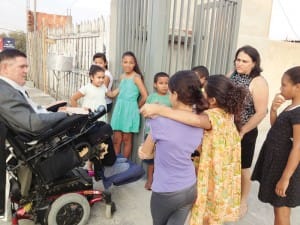As a Baptist missionary, John Leonard has served in some of Brazil's most impoverished areas. In 2005, he was targeted by gunfire and left for dead. His story reflects the power of hope, love, and teamwork.
Posted
by The Iowa Clinic on Tuesday, September 8, 2015
 Your Local Health | Written by BJ Towe
Your Local Health | Written by BJ Towe
Born in Des Moines, 55-year-old John Leonard spent most of his childhood years with his missionary parents, brother, and three sisters serving in some of northeast Brazil's poorest areas. His love for the Brazilian people grew – as did his boundless passion for protecting children from prostitution, drugs, and child trafficking. By the time Leonard was 17, he volunteered to move into the mountains to reopen a failed church on his own.
“The area had about 6,000 or 7,000 people – with no schools, no electricity, no running water, no medical help. I was basically their doctor. I had been trained to give animals sutures and shots. The government gave me medicines to take care of the livestock, which were basically the same as we'd use. So we used them to care for the people,” Leonard recalls.
After four years and with the church thriving, Leonard came to the United States, earned his pastoral and missions major from a Bible college, and got married. He and Bev had their first two children and then packed their bags to head to Brazil in 1990.
As missionaries with Baptist Mid-Missions, the Leonards planted and built three different churches, each one growing to the point where it could be handed over to Brazil's national ministry.
Serving in a drug-infested slum
In 2005, the Leonards were asked to plant a church in a slum in Alagoas, the poorest state in Brazil.
“It's very primitive – there is basically one water faucet for every 500 or 600 people. Healthcare is almost zero. There's a lot of poverty, prostitution, drugs, and alcohol. People sell their children – as young as 9 to 11 years old – to get money for drugs,” Leonard says. “Stuff like that was going on right by the church.”
The Leonards worked tirelessly to improve conditions for the community. They lobbied for paved roads and jobs for residents. They helped better education, and they rehabilitated drug addicts.
After the two local drug lords had successfully banished police from the area, Leonard made a point to repeatedly ask them if the church and its families were safe to stay. They said they were.
But when the Leonards went from helping a handful of people get off drugs to helping dozens of people get off drugs, “It was weighing on the drug lords' pockets,” Leonard says. That put him squarely in their crosshairs.
On July 3, 2005, after his Sunday-evening sermon, Leonard greeted people outside the church as they left. Two men approached Leonard and took him aside. These men, hired by the drug lords, shot Leonard at close range — six times – in his left arm, back, and face. The bullet that struck his back lodged in his spinal cord around the neck, causing him to lose feeling in his arms and legs.
Loaded into the back of a car, Leonard endured agonizing miles riding over bumpy and dusty roads on the way to the hospital. Because his injuries were so severe, doctors didn't want to move him, so they did some surgery there. Still, the bullet remained lodged in his spine and Leonard remained in the jungle – critically wounded, sweating, and unable to move.
“Everyone expected me to die,” Leonard says.
Flown to Iowa for medical care
On the sixth day after the shooting, Leonard slipped into a coma. With help from Senator Charles Grassley, transportation back to Iowa via Lear jet was arranged. He was severely injured and had been laying there in dirty, hot conditions. Naturally, he was in rough condition. He was paralyzed from the neck down and had pneumonia in both lungs. He also had a staph infection – and the bullet that struck his left arm left it almost completely shattered.
The bullet in John's neck was lodged between the C4 and C5 vertebrae. In a way, he was lucky. His spinal cord injury was just low enough that the phrenic nerve still worked, which extends from the neck to the diaphragm and allows a person to breathe. If the bullet had been any higher, that nerve wouldn't have worked. Like the late Christopher Reeves (who required a ventilator to breathe following his neck injury), he wouldn't have been able to breathe on his own.
Leonard was in a coma for a total of 12 days.
An unwavering passion to serve
Although Leonard was permanently paralyzed in his legs and left with only partial use of his arms, the next step for the medical team was to help him do what he wanted most – to return to Brazil and continue his work there.
In June 2007, Leonard returned to Brazil – this time, in a wheelchair.
Leonard's story is one of hope.
Despite the health and mobility challenges, there's little Leonard won't tackle. After all, his work is not done yet. His passion for his ministry bubbles inside him like a wellspring of hope. That's why, after spending six months in Iowa, the Leonards will again return to Brazil in October.
This time, they'll plant a church and serve the 170 families on an Indian reservation. And again, his family, congregation, and medical team are cheering him on.